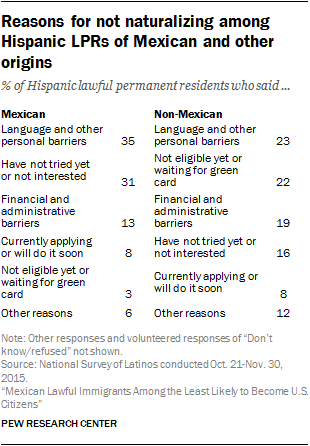
Despite their very low rate of naturalization, many Mexican lawful immigrant adults who had not yet naturalized said they wanted to do so, according to the 2015 Pew Research Center survey. For example, nearly all (98%) said they would naturalize if they could, and about two-thirds (67%) said they had researched the administrative steps needed to become a U.S. citizen, an indication of their interest in seeking U.S. citizenship. In addition, 70% said they did not intend to return to Mexico and live there later in life, a further indication of the potential interest of Mexican immigrants in applying for U.S. citizenship and staying in the United States.
Even so, these same immigrants cited many reasons for not having applied for U.S. citizenship yet. Among Mexican lawful permanent residents, about a third (35%) said in an open-ended question that the primary reason for not naturalizing was either language or personal barriers. Another 31% said they had either not tried to apply for naturalization yet or were not interested. An additional 13% cited financial or administrative barriers.
Looking more deeply at the reasons Mexican lawful permanent residents gave for not having naturalized, 27% said they needed to learn English (the leading reason among cited language and other personal barriers). Another 18% said they had not applied because they did not have the time to do so (the leading reason among those saying they had not tried to apply or had no interest). And 8% cited the cost of the application as the reason they have not yet naturalized (the leading reason among cited financial and administrative barriers).
In addition, 8% said they either were currently applying for U.S. citizenship or would do so within the next year. And 3% said they were not yet eligible to naturalize.9
The survey also revealed that although a large majority of Mexican green-card holders said they had done research into the steps to become U.S. citizens, only 16% knew how many tests would be required during the application process, suggesting that even though many have explored what it would take to become a U.S. citizen, many still did not fully understand the process.
Differences between Mexican and non-Mexican Hispanic lawful permanent residents for not seeking U.S. citizenship

Latino lawful immigrants from countries other than Mexico had a significantly higher rate of naturalization than their Mexican counterparts (62% vs. 42% in 2015). However, in general terms, both groups showed similar levels of motivation to apply for naturalization, and faced similar barriers in their path to U.S. citizenship, according to the Pew Research Center survey.
Among non-Mexican Latino lawful immigrants, 94% said they would naturalize if they could, and 66% said they were planning to stay in the U.S. and not return to their home countries (compared with 98% and 70% among Mexican lawful immigrants).
In addition, non-Mexican lawful Latino immigrants were as likely as Mexican lawful immigrants to have said they had researched the steps to become a U.S. citizen (80% of non-Mexican vs. 67% of Mexican lawful immigrants). However, only 21% Latino green-card holders of other origins correctly said that they needed to take two tests to gain U.S. citizenship, similar to the share among Mexican lawful immigrants (16%).
In terms of specific barriers to naturalization, Hispanic lawful permanent residents of non-Mexican origin and those of Mexican origin cited somewhat similar reasons for not naturalizing. Mexican lawful immigrants were as likely as their non-Mexican Hispanic counterparts to have said that language and other personal reasons were the main barriers for them to become naturalized U.S. citizens (35% vs. 23%, respectively). By contrast, Mexican green-card holders were significantly more likely than non-Mexican Hispanics to show a lack of interest or said they had not had time to take steps to naturalize (31% vs. 16%).
Not being eligible yet for naturalization or waiting for their green card was the main reason for 22% of non-Mexican Latino lawful permanent residents, while only 3% of Mexican LPRs said this.10 Also, financial and administrative issues were just as important to non-Mexican Latino lawful permanent residents (19%) as to Mexican lawful permanent residents (13%).




